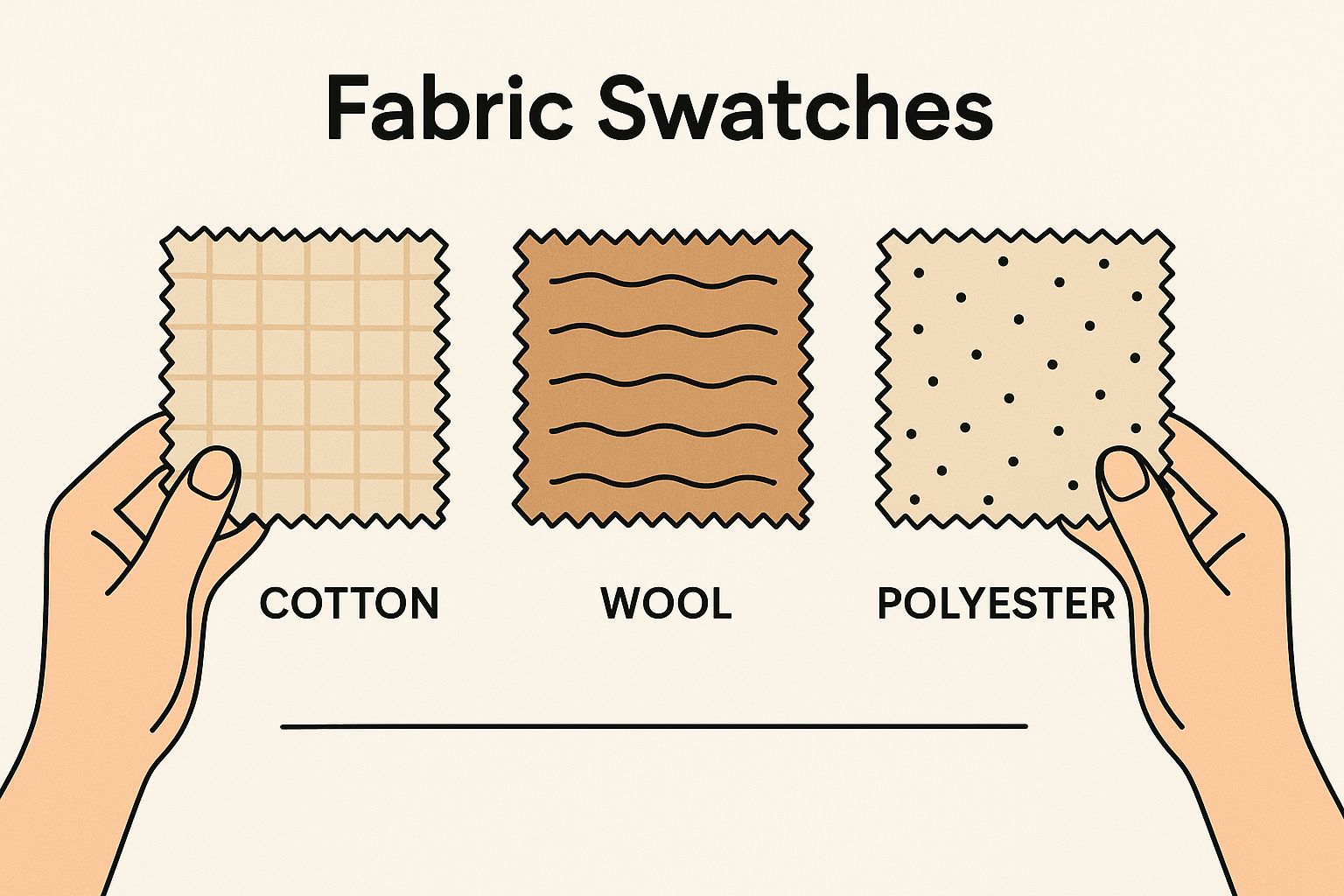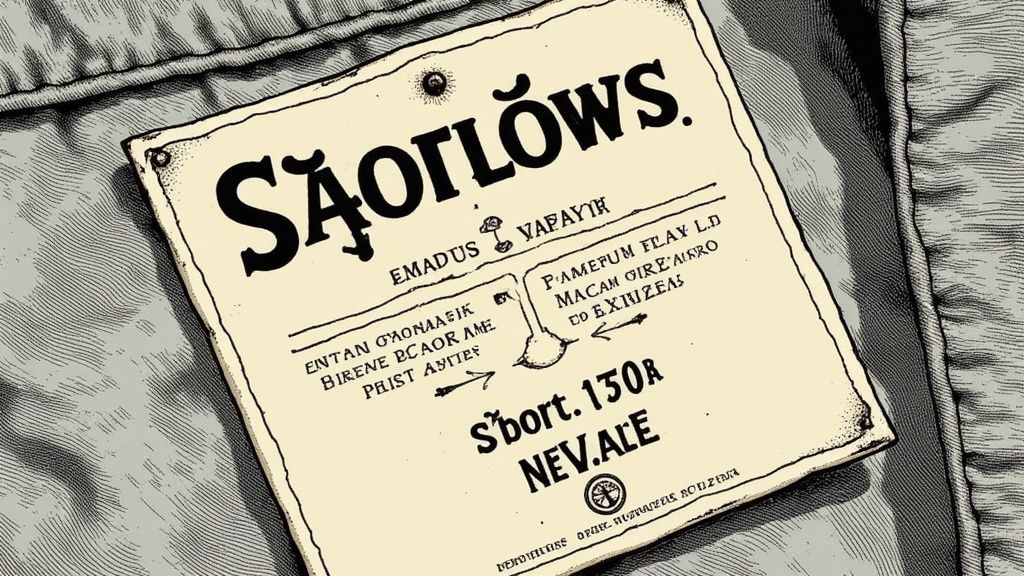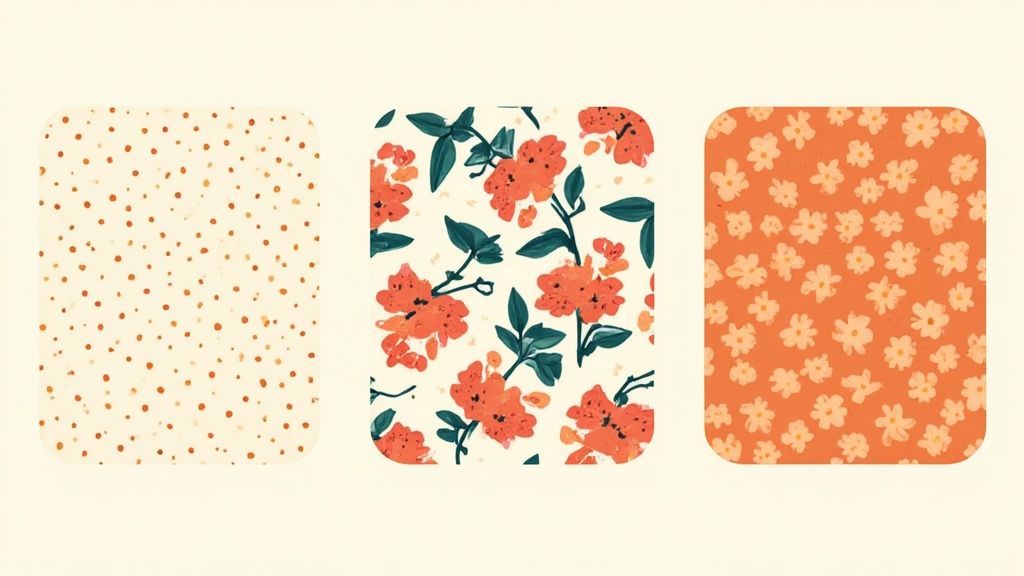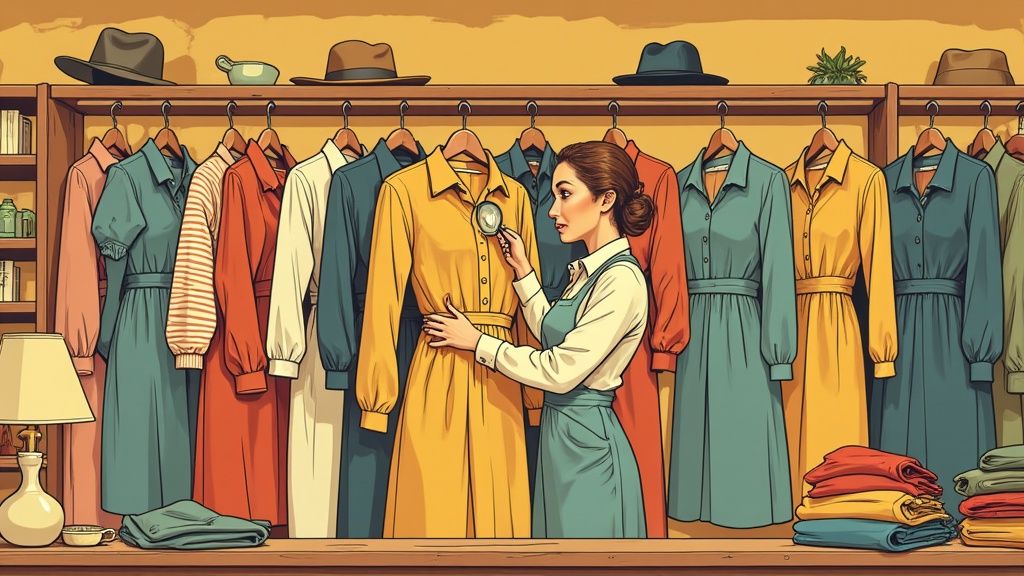Getting Your Vintage Eye Sharp From Day One
Walking into a vintage shop for the first time can feel a bit like stepping into a time machine, but it can also be overwhelming. Everywhere you look, there are clothes whispering stories of decades past. It's easy to get caught up in the romance of it all and buy something that looks vintage but is actually a modern reproduction. The real key to successful vintage hunting? Knowledge. Understanding the market is just as important as recognizing a quality garment.
For example, the rise of sustainable fashion has had a huge impact on the vintage world. Increased demand has pushed the value of authentic vintage clothing way up, but it's also led to a surge in really convincing fakes. It’s like a cat-and-mouse game, and you have to be one step ahead.
This means you've got to be patient and strategic. Think of serious vintage collectors as treasure hunters. They don't just wander around hoping to stumble upon something amazing. They do their research. They know what’s rare, what’s in demand, and what’s likely to be reproduced. This helps them spot the real gems amongst the costume jewelry, so to speak. This market awareness is really the foundation of good vintage identification. The economics of it all play a surprisingly large role. The economics of vintage fashion are fascinating, especially how consumer interest in sustainability is driving the market.
Developing Your Authentication Instincts
So, how do you develop this all-important "vintage eye"? It doesn’t happen overnight. It’s more of a gradual process, like learning a new language. Here are a few things to focus on:
- Market Awareness: Do some digging and find out which brands and styles are hot right now. These are the ones most likely to be reproduced. A little healthy skepticism goes a long way.
- Patience is Key: Don’t impulse buy! Take your time examining a piece. Turn it inside out, check the seams, look at the label. Compare it to pictures of authentic vintage online or in a guidebook.
- Build a Network: Talk to people! Connect with experienced collectors and dealers, online or in person. Vintage communities are often incredibly generous with their knowledge. They’ve been there, done that, and they're usually happy to share their expertise.
From Casual Browser to Serious Treasure Hunter
These strategies will help you shift your mindset from casually browsing to strategically hunting. I remember when I first started collecting; I was grabbing anything that looked remotely old. Thankfully, a more experienced collector took me under her wing. She showed me the tiny details – the stitching, the labels, the way the fabric drapes – that separate the real deal from the reproductions. It completely changed the way I shopped.
Trust me, learning to spot these nuances is a game-changer. By developing your authentication instincts and approaching vintage shopping with a strategic mindset, you’ll be well on your way to finding those truly special pieces and avoiding expensive mistakes. It's a journey, but the thrill of unearthing that perfect vintage garment is absolutely worth the effort.
Decoding Fashion's Time Capsule Through Silhouettes

This infographic gives you a great visual starting point for differentiating vintage fabrics like cotton, wool, and polyester. It really highlights how even subtle differences in the weave and texture can be big clues when you're trying to figure out a garment's age. Trust me, developing that tactile sense is a game-changer in vintage identification.
One of the first things I check is the silhouette, because counterfeiters often get this wrong. I remember someone showing me the difference between a 1940s shoulder and a 1980s power shoulder—total lightbulb moment! The structured lines of the '40s, so influenced by wartime rationing and practicality, are just worlds apart from the bold, exaggerated '80s silhouette. These distinctions are so important.
Why Silhouettes Matter
Fashion is a mirror reflecting the times. Imagine the flowing, bohemian lines of the '70s trying to exist in the sleek, minimalist '90s—it just wouldn't work! This historical context is essential for authenticating vintage pieces. Savvy collectors use this knowledge as their first filter. It lets them quickly weed out obvious mismatches before they even get close enough to touch the fabric.
Dating a vintage garment starts with analyzing the silhouette to narrow down the potential era. Then, examining the fabric, buttons, and labels helps you hone in on more specific clues. For example, RN numbers, issued by the Federal Trade Commission, can be really insightful, especially for U.S. garments made between 1952 and 1959. Little details like these can unlock a garment's story. Want to learn more about vintage clothing identification? This is a great resource.
Training Your Eye
Silhouette analysis helps you narrow down a piece's era almost instantly. This gives you a huge leg up when buying or selling. It's all about training your eye to recognize the subtle nuances of fashion history, so you can quickly spot potential treasures. With a bit of practice, you'll be able to pinpoint eras within seconds of picking up a garment.
To help you visualize these differences, I've put together a handy table:
Decade-by-Decade Silhouette Guide: This table provides a visual comparison of key silhouette characteristics across different vintage eras.
| Decade | Key Silhouette Features | Distinctive Design Elements | Common Garment Types |
|---|---|---|---|
| 1920s | Dropped waist, loose fit, knee-length skirts | Art Deco embellishments, beaded details, flapper dresses | Dresses, cloches, coats |
| 1930s | Bias-cut gowns, figure-hugging silhouettes, longer hemlines | Ruffles, delicate fabrics like silk and satin | Evening gowns, tailored suits, blouses |
| 1940s | Broad shoulders, nipped-in waists, A-line skirts | Shoulder pads, utilitarian details, wartime rationing influences | Suits, dresses, skirts |
| 1950s | Full skirts, cinched waists, petticoats | Floral prints, feminine details, poodle skirts | Dresses, skirts, petticoats |
| 1960s | A-line shifts, mini skirts, boxy silhouettes | Bold geometric patterns, Mod styles | Mini skirts, shift dresses, A-line coats |
| 1970s | Flowing maxi dresses, flared pants, bohemian styles | Paisley prints, earthy tones | Maxi dresses, bell bottoms, peasant blouses |
| 1980s | Power shoulders, oversized silhouettes, bright colors | Shoulder pads, bold prints, statement jewelry | Blazers, leggings, oversized sweaters |
| 1990s | Minimalist silhouettes, slip dresses, grunge styles | Understated designs, simple fabrics | Slip dresses, jeans, oversized shirts |
As you can see, each decade has its own distinct style. By familiarizing yourself with these key features, you can quickly and confidently date vintage clothing. This knowledge will be invaluable as you continue your vintage journey.
Cracking The Label Code Like A Vintage Detective

Labels. They're more than just itchy bits of fabric sewn inside our clothes. Think of them as tiny historical documents, whispering secrets about a garment's past. Over the years, I've realized that understanding these "secret codes" is crucial for authenticating vintage finds.
Honestly, for me, label analysis became one of the fastest ways to learn how to identify vintage clothing. Everything from the label's construction and font to its wording (especially the country of origin) can be incredibly telling. It's like detective work, piecing together clues to reveal a garment's true age.
One of my first go-to checks is the "Made in" tag. The shift from "Made in USA" to overseas production is a surprisingly powerful dating tool. For instance, a vintage Nike item made in the USA is often a real gem, pointing to the brand's earlier manufacturing days. It’s interesting how similar authentication principles pop up in other collecting fields. Take antique furniture for example—the details matter! Check out our guide on identifying antique furniture.
Decoding the Details
So, what exactly do I look for on a vintage label? Here are a few of my personal checkpoints:
Font Style: Fonts evolve, just like fashion. Vintage labels often have distinctive typefaces that are instantly recognizable once you train your eye. It's these subtle details that counterfeiters often miss.
Material: Is the label thick and woven, or thin and printed? This can indicate different manufacturing eras and quality levels. In my experience, a finely woven label often signifies a higher-end piece.
RN Numbers: These registered identification numbers (found on American-made garments) are especially helpful for dating items from the 1950s through the 1970s. They’re like puzzle pieces helping you build a timeline.
The Importance of Authentication
With the rise of fast fashion and online marketplaces, authenticating vintage clothing has never been more important. And label examination is a key part of that process. Older tags have distinct characteristics, whether it's the font, material, or information provided. Learn more about authenticating vintage fashion. Given that an estimated 26% of luxury goods worldwide are counterfeit, it pays to develop a sharp eye. It’s not just about avoiding fakes—it’s about appreciating the real deal.
Remember, you're not just reading words on a label; you're uncovering a story. These small fabric rectangles reflect historical manufacturing techniques, brand evolution, and even the social and economic influences on fashion trends. With a little practice, you'll be able to see those stories unfold. They're more than just labels – they're keys to unlocking the fascinating world of vintage fashion.
When Fabric Becomes Your Truth Detector
Ever touch a real 1960s wool coat? Then compare it to a modern reproduction. The difference is night and day. Fabric is a major key to unlocking the secrets of vintage clothing authentication. Fabric composition and construction have changed so much over the years, creating telltale signs that often get missed. Modern synthetics might look vintage in a photo, but they just don't feel the same. Honestly, I can often pinpoint a garment's era just by its texture and weight.
The Tactile Language of Vintage
The drape of a garment, the way it ages, even the smell of real vintage tells a story that reproductions just can’t copy. Think about a slinky rayon crepe dress from the 1930s. That fabric has this amazing weight and fluidity you won't find in a modern polyester knock-off. Or the crisp, almost architectural feel of a 1940s linen suit—modern linen often feels flimsy in comparison.
Honing your "tactile vintage skills" is crucial. This means getting to know how different fiber blends behaved in different decades. For example, polyester first appeared in the 1950s, but it really exploded in the 70s. So, if you see polyester in something claiming to be from the 1930s? Massive red flag. Understanding these fabric timelines is like having a cheat code for vintage shopping.
Construction Clues and Aging Authenticity
Construction methods offer just as many clues. Vintage seaming, zipper placements, and button materials all shifted with technology and fashion trends. Take zippers. Metal zippers were common in earlier decades, while plastic ones became more popular later. A plastic zipper on a supposed 1940s dress? Definitely something to look into.
And then there’s aging. Real aging is different from artificial distressing. True vintage develops this amazing patina—colors soften, the fabric might have slight fading or wear in certain areas. Reproductions try to fake this, but it always looks forced. I once saw a reproduction 1970s denim jacket with this weird, patchy bleaching. A real one fades naturally along the seams and creases.
To illustrate these differences across the decades, I've put together a helpful table:
Vintage Fabric and Construction Timeline
Evolution of fabric types, construction techniques, and hardware across vintage eras
| Era | Common Fabrics | Construction Methods | Hardware Details | Aging Characteristics |
|---|---|---|---|---|
| 1920s | Silk, Rayon, Wool | Bias-cut dresses, dropped waists | Metal zippers, ornate buttons | Delicate fabrics, some fraying, subtle color fading |
| 1930s | Rayon crepe, Silk velvet | Bias-cut gowns, puff sleeves | Glass buttons, decorative buckles | Soft patina, some fabric weakening, creasing |
| 1940s | Linen, Rayon, Wool gabardine | A-line skirts, structured tailoring | Metal zippers, Bakelite buttons | Crisp fabrics (unless heavily worn), gentle wear patterns |
| 1950s | Cotton, Wool, Early Polyester | Full skirts, fitted bodices | Plastic zippers, pearl buttons | Vibrant colors (if well-preserved), some pilling |
| 1960s | Wool, Acrylic, Modacrylic | Shift dresses, A-line coats | Metal and plastic zippers | Bold colors, sometimes slightly faded, some shrinkage |
| 1970s | Polyester, Denim, Crochet | Bell bottoms, flared sleeves | Metal and plastic zippers | Fading, especially denim, some discoloration from washing |
This table gives a general overview; obviously, there's a lot more to it. But you can start to see how these elements change over time.
From Novice to Expert: Building Your Fabric Knowledge
So how do you develop this sixth sense for vintage fabric? It’s all about practice. Here are a few tips to get you started:
- Touch Everything: Seriously, when you’re in a vintage shop, touch all the fabrics. Feel the weight, the drape, the texture. Compare different fabrics from different eras.
- Research Fabric History: There are tons of resources out there, online and in books, about fabric history. Curio offers some in-depth articles about the materials and history of vintage clothing.
- Build a Reference Library: This might sound a little geeky, but start collecting swatches of different vintage fabrics. It's like having a hands-on encyclopedia of vintage textiles.
By building your knowledge of fabrics and construction, you'll learn to assess quality with confidence and spot the details that set real vintage apart from the fakes. It’s this hands-on approach, combined with a little historical knowledge, that transforms you from a casual shopper into a true vintage detective.
Dodging Vintage Scams And Sophisticated Fakes

This screenshot from Wikipedia's "Counterfeit consumer goods" page really drives home how widespread counterfeiting is. It's everything from luxury handbags to, you guessed it, vintage clothing. Seeing the sheer volume of fake goods out there underscores why authentication is so important.
Unfortunately, the vintage market is a prime target for scammers. Some are incredibly good at making new items look old, fooling even experienced collectors. I've even heard horror stories of people paying a fortune for supposedly rare pieces, only to find out later they were cleverly aged reproductions. Brands with high resale value, like a classic Chanel jacket or a pair of vintage Levi's, are particularly susceptible. This makes knowing your vintage all the more crucial.
Recognizing Red Flags and Asking the Right Questions
The rise of online vintage shopping has created a whole new set of challenges. Because you can’t examine a piece in person, it's easier for scammers to take advantage of unsuspecting buyers. But, the experienced vintage hunter knows the right questions to ask to expose a seller's true knowledge (or lack thereof).
For example, asking detailed questions about the garment’s construction can reveal whether a seller actually understands vintage manufacturing techniques. Inconsistent pricing can also be a major red flag. If a deal seems too good to be true, it probably is. Trust your gut.
Another crucial tactic? Compare the item to authentic vintage examples. This helps you spot inconsistencies in labels, fabrics, or construction. These small details are often what separates a genuine vintage gem from a well-made fake. Learning the difference between natural aging and artificial distressing is key, too. Authentic vintage garments wear and fade organically over time, while fakes often have an unnatural, almost “too perfect” distressed look. For more tips on identifying antiques in general, you might find this article helpful.
The Importance of Trusted Dealers
Navigating the vintage world can feel like a minefield sometimes, which is why building relationships with reputable dealers is so important. These dealers have built their businesses on authenticity. They're often an invaluable resource, not just for buying vintage, but for learning how to identify it, too. Think of them as your mentors in the world of vintage collecting. They can offer incredible insights into specific brands and eras.
By combining their expertise with your own growing knowledge, you'll become a much more confident vintage shopper. You'll be better equipped to spot those red flags and snag the real treasures, leaving the fakes behind.
Building Your Personal Vintage Authentication Arsenal
Authenticating vintage clothing isn't just about knowing facts and figures. It's like putting together a puzzle, gathering clues and evidence to build a solid case. It’s about cultivating a sharp eye and, honestly, a bit of a sixth sense. Over time, you'll start to recognize the tell-tale signs of true vintage. The best collectors I know combine their online research with hands-on examination, creating a personalized “authentication arsenal.”
Power Up Your Vintage Hunting With Digital Tools
So, what belongs in this arsenal? Digitally, you've got a wealth of resources. Websites and apps can help you decipher those tricky vintage labels, identify fabrics, and delve into brand histories. I use a mix of online databases, vintage forums, and even social media groups dedicated to specific brands or eras. For example, when I'm stumped by a particularly strange label – which happens more often than you’d think! – online communities are my go-to. The collective knowledge is amazing, and I can't tell you how many times they’ve saved me from a pricey mistake.
Don't underestimate the power of magnification. A good magnifying glass or a jeweler's loupe allows you to see the tiny details – the weave of the fabric, the nuance of the stitching, the construction of the label – that you'd miss with the naked eye. This is especially useful for inspecting seams and stitching, which can be major clues for dating a piece.
Hands-On Techniques and Community Wisdom
Getting hands-on is crucial. Photography is your best friend. Take clear, detailed photos of the garment, including close-ups of labels, tags, and any unique features. These come in handy when you're seeking a second opinion. Don't be shy about reaching out to more experienced collectors or vintage dealers. The vintage community is generally incredibly willing to share their knowledge. A quick photo can often prevent a costly error.
Another tip? Build your personal library of authentic vintage pieces. Every time I find a special piece, I document it. I photograph it in detail and note the fabric, the construction, the label – anything that stands out. This personal database becomes an invaluable reference tool.
Systematize Your Approach for Long-Term Success
Authenticating vintage isn't about luck; it’s about building a systematic approach. I've created checklists for myself, based on my specific collecting interests. They remind me to check key features of certain eras or brands I’m interested in. This eliminates the guesswork and lets me make informed decisions on my own. It turns casual vintage shopping into a strategic treasure hunt, armed with the knowledge to uncover the real gems.
Your Complete Vintage Authentication Game Plan
So, you’re ready to level up your vintage game? It’s about more than just knowing the basics – it's about putting it all together into a system you can rely on. The seasoned vintage hunters out there? They aren't just lucky. They have a process, a way of combining all the authentication techniques, whether they’re browsing online, at an estate sale, or in a chic vintage boutique.
Building Your Vintage Eye Over Time
Let’s be real, developing a “vintage eye” isn’t an overnight thing. Even those who have been doing this for years are constantly learning! Think of it like any other skill – the more you practice, the sharper you get. I recommend starting with something fairly straightforward, like vintage denim. Denim ages so distinctively, it’s a fantastic training ground. As your confidence grows, you can venture into more specialized areas, maybe 1930s day dresses or glamorous 1950s couture. Setting realistic goals is key – don’t expect to become an expert on everything all at once. For extra tips and deeper dives, I often check out the Curio blog; they have some seriously insightful guides on vintage identification.
Essential Checklists For Every Vintage Hunt
Checklists? Seriously? Yes, seriously! They're especially helpful in the beginning. When I'm casually browsing, my mental checklist includes things like:
- Checking the Label: I’ll look for clues like “Made in USA” tags, RN numbers, or anything that feels off for the supposed era.
- Feeling the Fabric: Does it feel vintage? Or does it have that slick, modern, synthetic vibe?
- Examining the Construction: Seams, zippers, buttons…these are all telltale signs. Do they line up with how things were made back in the day?
Of course, if you're looking at higher-value pieces, a more thorough evaluation is a must. That might mean researching the brand’s history, comparing the item to documented authentic examples, or even reaching out to a trusted vintage expert.
From Beginner to Expert: A Realistic Timeline
Honesty about where you are in your vintage journey is crucial. It's tempting to dive into the deep end, but trust me, building a solid foundation is worth it. Focus on those core skills first – label analysis, fabric identification, recognizing silhouettes – before tackling tougher challenges like spotting those sneaky artificially aged reproductions. Keep track of your progress, celebrate your wins, and don’t be afraid to tap into the knowledge of the vintage community. The more you do this, the more you'll hone that instinct for spotting true vintage, that “I know it when I see it” confidence that comes with experience. Ready to take your vintage hunting game to the next level? Download Curio today and let those treasures reveal their stories. Curio helps you uncover the history and value of the things you love, turning your vintage finds from intriguing mysteries into meaningful discoveries.
